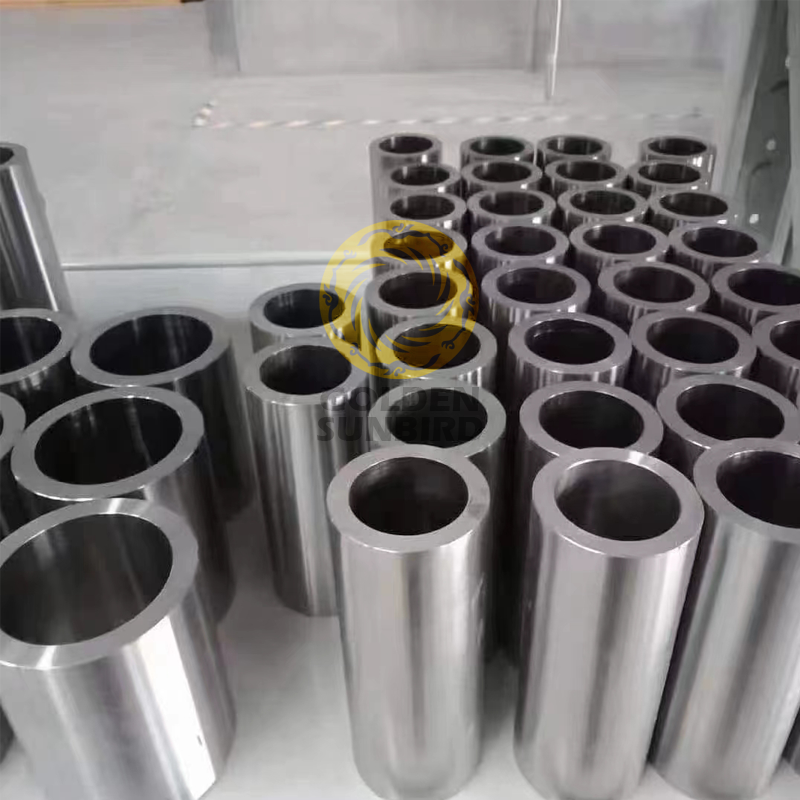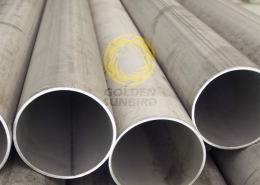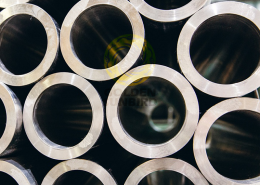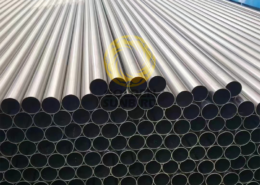ASTM B521 Tantalum and Tantalum Alloy Tube
- Type: Seamless and Welded Tube
- UNS Grade R05400—Unalloyed Tantalum, powder-metallurgy consolidation
- UNS Grade R05200—Unalloyed Tantalum, VAM
- UNS Grade R05252—Tantalum + 2.5% Tungsten alloy, VAM (Ta2.5W)
- UNS Grade R05255—Tantalum + 10% Tungsten alloy, VAM (Ta10W)
- UNS Grade R05240—Tantalum alloy, 60% Tantalum, 40% Niobium, EB furnace, VAM, or both (Ta40Nb)
Features
ASTM B521 Seamless and Welded Tantalum Tube, and Tantalum Alloy Tube
UNS Grade R05400—Unalloyed tantalum, powder-metallurgy consolidation.
UNS Grade R05200—Unalloyed tantalum, vacuum melted.
UNS Grade R05252—Tantalum + 2.5 % tungsten alloy, vacuum melted.
UNS Grade R05255—Tantalum + 10 % tungsten alloy, vacuum melted.
UNS Grade R05240—Tantalum alloy, 60 % tantalum, 40 % niobium, electron-beam furnace, vacuum arc melt, or both.
Chemical Composition (Ingot Chemical Requirements wt.%)
| Element | R05200 | R05400 | R05252 | R05255 | R05240 |
| Oxygen (O) | Max 0.015% | Max 0.030% | Max 0.015% | Max 0.015% | Max 0.020% |
| Nitrogen (N) | Max 0.010% | Max 0.010% | Max 0.010% | Max 0.010% | Max 0.010% |
| Carbon (C) | Max 0.010% | Max 0.010% | Max 0.010% | Max 0.010% | Max 0.010% |
| Hydrogen (H) | Max 0.0015% | Max 0.0015% | Max 0.0015% | Max 0.0015% | Max 0.0015% |
| Niobium (Nb) | Max 0.10% | Max 0.10% | Max 0.50% | Max 0.10% | 35.0-42.0% |
| Tungsten (W) | Max 0.050% | Max 0.050% | 2.0-3.5% | 9.0-11.0% | Max 0.050% |
| Tantalum (Ta) | (Remainder) | (Remainder) | (Remainder) | (Remainder) | (Remainder) |
Mechanical Properties
| Grade | Ultimate Tensile Strength (min) | Yield Strength (0.2% offset, min) | Elongation (min) |
| R05200/R05400 | 30,000 psi (207 MPa) | 20,000 psi (138 MPa) | 25% |
| R05252 | 40,000 psi (276 MPa) | 28,000 psi (193 MPa) | 20% |
| R05255 | 70,000 psi (481 MPa) | 60,000 psi (414 MPa) | 15% |
| R05240 | 40,000 psi (276 MPa) | 28,000 psi (193 MPa) | 20% |
Technical Specifications
| Specification | Value |
| Standard | ASTM B521 Tantalum and Tantalum Alloy Seamless and Welded Tubes |
| Grade | UNS Grade R05400—Unalloyed tantalum, powder-metallurgy consolidation, UNS Grade R05200—Unalloyed tantalum, vacuum melted, UNS Grade R05252—Tantalum + 2.5% tungsten alloy, vacuum melted. (Ta2.5W) UNS Grade R05255—Tantalum + 10% tungsten alloy, vacuum melted. (Ta10W) UNS Grade R05240—Tantalum alloy, 60% tantalum, 40% niobium, electron-beam furnace, vacuum arc melt, or both. (Ta40Nb) |
| Seam Type | Seamless and Welded |
| Finish | Clean, smooth finish |
| Tube Size | Outside Diameter (OD) Range: 9.53-88.9mm, Wall Thickness (WT) Range: 0.5-12.7mm |
| Length | 100-6000mm |
| Inspection Certificate | EN 10204 Type 3.1 (Mill Test Certificate), EN 10204 Type 3.2 (Witness Testing or 3rd Party Inspection) |
| Tests | Chemical analysis, Tensile test, Flaring test, Reverse Flattening test, NDE Tests (Hydrostatic, Pneumatic, or Ultrasonic tests) |
Features
Excellent Corrosion Resistance: Tantalum is renowned for its exceptional resistance to corrosion in a wide range of environments, including acids, alkalis, and salt solutions.
High Melting Point: Tantalum boasts a very high melting point, making it suitable for high-temperature applications.
Biocompatibility: Tantalum exhibits good biocompatibility, making it a valuable material for some medical implants.
Good Strength and Ductility: These tubes possess a good balance of strength and ductility, allowing for some forming and shaping.
Packing
Packed in plywood boxes.
Application
UNS Grade R05400 (Unalloyed Tantalum, Powder-Metallurgy Consolidation) and UNS Grade R05200 (Unalloyed Tantalum, Vacuum Melted)
Chemical Processing Industry: These grades are extensively used in the chemical processing industry for constructing reaction vessels, heat exchangers, condensers, piping systems, and pumps due to their unparalleled resistance to acids, except for hydrofluoric acid and strong alkalis.
Semiconductor Manufacturing: This material is used in the fabrication of components for semiconductor manufacturing equipment, where their resistance to corrosion by aggressive chemicals is crucial.
UNS Grade R05252 (Tantalum + 2.5% Tungsten Alloy, Ta2.5W, Vacuum Melted) and UNS Grade R05255 (Tantalum + 10% Tungsten Alloy, Vacuum Melted)
Aerospace and Aviation: These alloys are used to manufacture engine components and other parts that require high strength and resistance to high-temperature environments.
Military Applications: These tantalum-tungsten alloys are used in the production of projectiles and other military hardware due to their high strength and resistance to corrosion and high temperatures.
Nuclear Reactors: These alloys’ corrosion resistance and high-temperature stability benefit components within nuclear reactors, such as heat exchangers and reactors themselves.
UNS Grade R05240 (Tantalum Alloy, 60% Tantalum, 40% Niobium, Ta40Nb, Electron-Beam Furnace, Vacuum Arc Melt, or Both)
Superconducting Super Collider: This specific alloy’s superconductivity properties are advantageous for superconducting supercolliders and other high-energy physics applications.
Aerospace: The high strength-to-weight ratio and corrosion resistance make it suitable for aerospace structural components and fuel systems.
Medical Devices: Tantalum and certain of its alloys, including Ta40Nb, are biocompatible, making them suitable for surgical implants, particularly those requiring high corrosion resistance and compatibility with human tissue.








